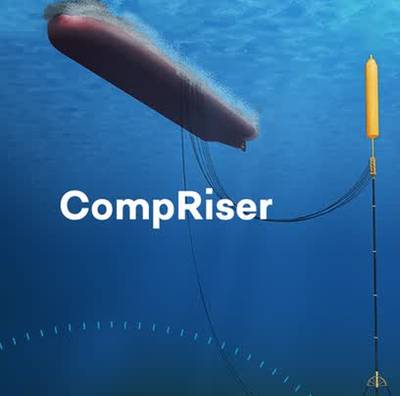The Brazilian oil and gas market has begun to heat up again with the resumption of the pre-salt block tenders, leading a range of service companies to gear up to offer a variety of new technologies aiming to help operators overcome the technological challenges posed by deep- and ultra-deepwater exploration and production.
Brazilian player Ocyan (formerly known as Odebrecht Oil & Gas), for example, has partnered with Magma Global to offer the deepwater markets the CompRiser, a hybrid riser system using a thermoplastic composition (TCP) duct. One of the advantages, according to Ocyan's subsea director, Marcelo Nunes, is corrosion resistance, as well as a series of differentiations that guarantee weight reduction, decreased installation time and costs.
"The CompRiser technology is a decoupled system. The structure, as a whole, connects to the production unit by means of jumpers. All the extra weight that the floating production storage and offloading unit (FPSO) receives is mainly from the jumpers. It does not receive the duct weight from the water depth, regardless of the depth," Nunes explained. "This is one of the main feature of CompRiser."
The traditional carbon steel risers at the extremities have been changed to the composite Magma duct. The duct floated and, consequently, allowed for the buoys that were added to ensure the buoyancy of this structure to be reduced or entirely eliminated. The entire structure is built on land, then plastered horizontally. Subsequently, it is placed vertically at the point of installation.
There are two main innovations. The first is the addition of composite risers in place of carbon risers. Consequently, guaranteeing an extended useful life due to its resistance of CO2 and H2S. It also guarantees the flexibility to connect to the flowline and, at the same time, gives the product buoyancy. The second innovation point is that this riser is more flexible than the rigid duct, allowing a direct connection with the flowline. Therefore, it is possible to eliminate two connectors by riser, drastically simplifying the concept.
This technology has, as its main target, application in deep- and ultra-deepwater fields. Ocyan has been betting on this solution since 2010. However, at that time, they used carbon steel. From 2015 onward, following the association with Magma and the in-house development conducted by Ocyan, technology gained form and maturity. It has become a solution in which Ocyan believes in and wants to compete in the global deepwater market.
 (Image: Ocyan)
(Image: Ocyan)
The developers point out that the product will use less than 20 percent of the load applied on the production units by similar solutions. The result of this difference can exceed 9,000 tons of force per FPSO, conditioned to the amount of risers in the project. In addition, they explain that the compact and modular manufacturing method enables a high index of local content. As the duct is delivered in coils and does not require soldering, assembly can be done in less than 30 days. According to Ocyan and Magma , the offshore installation takes another 20 days, without the need of special vessels and with little exposure to bad weather conditions. Consequently, the technology enables weight reductions, connection time, shorter loading time on the FPSO and shorter bundle mount time.
Nunes revealed that the technology is in the process of qualification by Petrobrás, and he also expressed the interest in taking the solution to other countries. "We will act outside Brazil, if there is opportunity and interest of third parties," he said.
"Magma has the qualification process already underway with Petrobrás. We are waiting for this phase to be completed to compete on an equal footing with other existing solutions," Nunes said. "We expect to compete with the rigid and flexible technologies, offering an alternative solution. And, of course, we will compete in fields for which this solution was made. The fields where we expect to compete are all deepwater and ultra-deepwater, such as Mero, Sepia, Pão de Açúcar, that is, all these areas belonging to Petrobrás and IOCs."
 Marcelo Nunes (Photo: Ocyan)
Marcelo Nunes (Photo: Ocyan)
Recently, Ocyan and Magma Global signed a term that integrates the BrasFels shipyard, located in Angra dos Reis in the south coast of Rio de Janeiro, to the project of the development of the riser tower system with CompRiser tubes. Ocyan's Nunes pointed out that the location, installed manufacturing capacity and reputation of the yard in the Brazilian market reduces the risk assessment of the project.
The president of Keppel Fels Brasil, Marlin Khiew, recalled the history in the construction, integration, updating and repair of a series of projects of the group in Latin America. He said the novelty will strengthen BrasFels' position as a provider of integrated solutions for deepwater production platforms.
Magma Global executive vice president Tony Duncan believes that yard fabrication means the project will become a reality in the near future. He pointed out that the solution will be highly effective for harsh deepwater environments such as the pre-salt. According to Duncan, the system has intelligent design that streamlines qualification needs in relation to the design of dynamic risers.